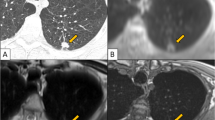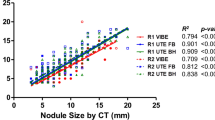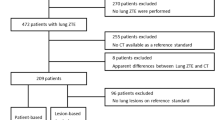Abstract
Objective
The purpose of this study was thus to compare capabilities for quantitative differentiation of non- and minimally invasive adenocarcinomas from other of pulmonary MRIs with ultra-short TE (UTE) obtained with single- and dual-echo techniques (UTE-MRISingle and UTE-MRIDual) and thin-section CT for stage IA lung cancer patients.
Methods
Ninety pathologically diagnosed stage IA lung cancer patients who underwent thin-section standard-dose CT, UTE-MRISingle, and UTE-MRIDual, surgical treatment and pathological examinations were included in this retrospective study. The largest dimension (Dlong), solid portion (solid Dlong), and consolidation/tumor (C/T) ratio of each nodule were assessed. Two-tailed Student’s t-tests were performed to compare all indexes obtained with each method between non- and minimally invasive adenocarcinomas and other lung cancers. Receiver operating characteristic (ROC)-based positive tests were performed to determine all feasible threshold values for distinguishing non- or minimally invasive adenocarcinoma (MIA) from other lung cancers. Sensitivity, specificity, and accuracy were then compared by means of McNemar’s test.
Results
Each index showed significant differences between the two groups (p < 0.0001). Specificities and accuracies of solid Dlong for UTE-MRIDual2nd echo and CTMediastinal were significantly higher than those of solid Dlong for UTE-MRISingle and UTE-MRIDual1st echo and all C/T ratios except CTMediastinal (p < 0.05). Moreover, the specificities and accuracies of solid Dlong and C/T ratio were significantly higher than those of Dlong for each method (p < 0.05).
Conclusion
Pulmonary MRI with UTE is considered at least as valuable as thin-section CT for quantitative differentiation of non- and minimally invasive adenocarcinomas from other stage IA lung cancers.
Clinical relevance statement
Pulmonary MRI with UTE’s capability for quantitative differentiation of non- and minimally invasive adenocarcinomas from other lung cancers in stage IA lung cancer patients is equal or superior to that of thin-section CT.
Key Points
• Correlations were excellent for pathologically examined nodules with the largest dimensions (Dlong) and a solid component (solid Dlong) for all indexes (0.95 ≤ r ≤ 0.99, p < 0.0001).
• Pathologically examined Dlong and solid Dlong obtained with all methods showed significant differences between non- and minimally invasive adenocarcinomas and other lung cancers (p < 0.0001).
• Solid tumor components are most accurately measured by UTE-MRIDual2nd echo and CTMediastinal, whereas the ground-glass component is imaged by UTE-MRIDual1st echo and CTlung with high accuracy. UTE-MRIDual predicts tumor invasiveness with 100% sensitivity and 87.5% specificity at a C/T threshold of 0.5.




Similar content being viewed by others
Abbreviations
- C/T ratio:
-
Consolidation/tumor ratio
- CTLung :
-
Thin-section standard-dose CT at lung window setting
- CTMediastinal :
-
Thin-section standard-dose CT at mediastinal window setting
- Dlong :
-
The largest dimension of each nodule
- Lung-RADS:
-
Lung Imaging Reporting and Data System
- solid Dlong :
-
The largest dimension of each nodule’s solid portion
- UTE:
-
Ultrashort echo time
- UTE-MRIDual1st echo :
-
Pulmonary MRI with ultra-short TE using dual-echo technique at first echo
- UTE-MRIDual2nd echo :
-
Pulmonary MRI with ultra-short TE using dual-echo technique at second echo
- UTE-MRISingle :
-
Pulmonary MRI with ultra-short TE using single-echo technique
References
Suzuki K (2017) Whack-a-mole strategy for multifocal ground glass opacities of the lung. J Thorac Dis. 9:S201–S207. https://doi.org/10.21037/jtd.2017.04.03
Okada M, Koike T, Higashiyama M, Yamato Y, Kodama K, Tsubota N (2006) Radical sublobar resection for small-sized non-small cell lung cancer: a multicenter study. J Thorac Cardiovasc Surg 132:769–775. https://doi.org/10.1016/j.jtcvs.2006.02.063
Suzuki K, Koike T, Asakawa T, Japan Lung Cancer Surgical Study Group (JCOG LCSSG) et al (2011) A prospective radiological study of thin-section computed tomography to predict pathological noninvasiveness in peripheral clinical IA lung cancer (Japan Clinical Oncology Group 0201). J Thorac Oncol 6:751–6. https://doi.org/10.1097/JTO.0b013e31821038ab
Asamura H, Hishida T, Suzuki K, Japan Clinical Oncology Group Lung Cancer Surgical Study Group et al (2013) Radiographically determined noninvasive adenocarcinoma of the lung: survival outcomes of Japan Clinical Oncology Group 0201. J Thorac Cardiovasc Surg 146:24–30. https://doi.org/10.1016/j.jtcvs.2012.12.047
Suzuki K, Watanabe S, Mizusawa J, Japan Lung Cancer Surgical Study Group (JCOG LCSSG) et al (2015) Predictors of non-neoplastic lesions in lung tumours showing ground-glass opacity on thin-section computed tomography based on a multi-institutional prospective study†. Interact Cardiovasc Thorac Surg. 21:218–223. https://doi.org/10.1093/icvts/ivv124
Saji H, Okada M, Tsuboi M, West Japan Oncology Group and Japan Clinical Oncology Group et al (2022) Segmentectomy versus lobectomy in small-sized peripheral non-small-cell lung cancer (JCOG0802/WJOG4607L): a multicentre, open-label, phase 3, randomised, controlled, non-inferiority trial. Lancet. 399:1607–1617. https://doi.org/10.1016/S0140-6736(21)02333-3
Revel MP, Mannes I, Benzakoun J et al (2018) subsolid lung nodule classification: a CT criterion for improving interobserver agreement. Radiology 286:316–325. https://doi.org/10.1148/radiol.2017170044
Yanagawa M, Kusumoto M, Johkoh T, Investigators of JSTR Lung Cancer Working Group et al (2018) Radiologic-pathologic correlation of solid portions on thin-section CT images in lung adenocarcinoma: a multicenter study. Clin Lung Cancer. 19:e303–e312. https://doi.org/10.1016/j.cllc.2017.12.005
Cui X, Fan S, Heuvelmans MA et al (2020) Optimization of CT windowing for diagnosing invasiveness of adenocarcinoma presenting as sub-solid nodules. Eur J Radiol. 128:108981. https://doi.org/10.1016/j.ejrad.2020.108981
Kanamoto Y, Sakao Y, Kuroda H et al (2021) Selection of pathological N0 (pN0) in clinical IA (cIA) lung adenocarcinoma by imaging findings of the main tumor. Ann Thorac Cardiovasc Surg 27:230–236. https://doi.org/10.5761/atcs.oa.20-00240
Ohno Y, Koyama H, Yoshikawa T et al (2011) T2* measurements of 3-T MRI with ultrashort TEs: capabilities of pulmonary function assessment and clinical stage classification in smokers. AJR Am J Roentgenol 197:W279-285. https://doi.org/10.2214/AJR.10.5350
Ohno Y, Nishio M, Koyama H et al (2013) Pulmonary MR imaging with ultra-short TEs: utility for disease severity assessment of connective tissue disease patients. Eur J Radiol 82:1359–1365. https://doi.org/10.1016/j.ejrad.2013.02.031
Ohno Y, Nishio M, Koyama H et al (2014) Pulmonary 3 T MRI with ultrashort TEs: influence of ultrashort echo time interval on pulmonary functional and clinical stage assessments of smokers. J Magn Reson Imaging 39:988–997. https://doi.org/10.1002/jmri.24232
Ohno Y, Koyama H, Yoshikawa T et al (2016) Pulmonary high-resolution ultrashort TE MR imaging: comparison with thin-section standard- and low-dose computed tomography for the assessment of pulmonary parenchyma diseases. J Magn Reson Imaging 43:512–532. https://doi.org/10.1002/jmri.25008
Ohno Y, Koyama H, Yoshikawa T et al (2017) Standard-, reduced-, and no-dose thin-section radiologic examinations: comparison of capability for nodule detection and nodule type assessment in patients suspected of having pulmonary nodules. Radiology 284:562–573. https://doi.org/10.1148/radiol.2017161037
Wielpütz MO, Lee HY, Koyama H et al (2018) Morphologic characterization of pulmonary nodules with ultrashort TE MRI at 3T. AJR Am J Roentgenol 210:1216–1225. https://doi.org/10.2214/AJR.17.18961
Ohno Y, Yui M, Chen Y, Kishida Y, Seki S, Yoshikawa T (2019) Gadolinium-based blood volume mapping from mri With ultrashort TE versus CT and SPECT for predicting postoperative lung function in patients with non-small cell lung cancer. AJR Am J Roentgenol 212:57–66. https://doi.org/10.2214/AJR.18.20095
Ohno Y, Takenaka D, Yoshikawa T et al (2022) Efficacy of ultrashort echo time pulmonary MRI for lung nodule detection and lung-RADS classification. Radiology 302:697–706. https://doi.org/10.1148/radiol.211254
Hatabu H, Ohno Y, Gefter WB, Fleischner Society et al (2020) Expanding applications of pulmonary MRI in the clinical evaluation of lung disorders: Fleischner Society Position Paper. Radiology. 297:286–301. https://doi.org/10.1148/radiol.2020201138
Schiebler ML, Parraga G, Gefter WB et al (2021) Synopsis from expanding applications of pulmonary MRI in the clinical evaluation of lung disorders: Fleischner Society Position Paper. Chest 159:492–495. https://doi.org/10.1016/j.chest.2020.09.075
Ohno Y, Seo JB, Parraga G et al (2021) Pulmonary functional imaging: Part 1-State-of-the-art technical and physiologic underpinnings. Radiology 299:508–523. https://doi.org/10.1148/radiol.2021203711
Gefter WB, Lee KS, Schiebler ML et al (2021) Pulmonary functional imaging: Part 2-State-of-the-art clinical applications and opportunities for improved patient care. Radiology 299:524–538. https://doi.org/10.1148/radiol.2021204033
Bland JM, Altman DG (1986) Statistical methods for assessing agreement between two methods of clinical measurement. Lancet 1:307–310
Bland JM, Altman DG (1999) Measuring agreement in method comparison studies. Stat Methods Med Res 8:135–160. https://doi.org/10.1177/096228029900800204
Ohno Y, Hatabu H, Takenaka D, Adachi S, Kono M, Sugimura K (2002) Solitary pulmonary nodules: potential role of dynamic MR imaging in management initial experience. Radiology 224:503–511. https://doi.org/10.1148/radiol.2242010992
Ohno Y, Koyama H, Nogami M et al (2007) STIR turbo SE MR imaging vs. coregistered FDG-PET/CT: quantitative and qualitative assessment of N-stage in non-small-cell lung cancer patients. J Magn Reson Imaging 26:1071–1080. https://doi.org/10.1002/jmri.21106
Ohno Y, Koyama H, Yoshikawa T et al (2012) Contrast-enhanced multidetector-row computed tomography vs. time-resolved magnetic resonance angiography vs. contrast-enhanced perfusion MRI: assessment of treatment response by patients with inoperable chronic thromboembolic pulmonary hypertension. J Magn Reson Imaging 36:612–623. https://doi.org/10.1002/jmri.23680
Hsu PK, Huang HC, Hsieh CC et al (2007) Effect of formalin fixation on tumor size determination in stage I non-small cell lung cancer. Ann Thorac Surg 84:1825–1829. https://doi.org/10.1016/j.athoracsur.2007.07.016
Goldstein NS, Soman A, Sacksner J (1999) Disparate surgical margin lengths of colorectal resection specimens between in vivo and in vitro measurements. The effects of surgical resection and formalin fixation on organ shrinkage. Am J Clin Pathol 111:349–351. https://doi.org/10.1093/ajcp/111.3.349
Pritt B, Tessitore JJ, Weaver DL, Blaszyk H (2005) The effect of tissue fixation and processing on breast cancer size. Hum Pathol 36:756–760. https://doi.org/10.1016/j.humpath.2005.04.018
Funding
Drs. Ohno, Nagata, and Toyama received a research grant from Canon Medical Systems Corporation, which also supported this work technically. Drs. Ohno and Takenaka received a research grant from Grants-in-Aid for Scientific Research from the Japanese Ministry of Education, Culture, Sports, Science and Technology (JSTS.KAKEN; No. 18K07675). Drs. Ohno and Toyama received research grants from Grants-in-Aid for Scientific Research from the Japanese Ministry of Education, Culture, Sports, Science and Technology (JSTS.KAKEN; No. 20K08037), and the Smoking Research Foundation.
Author information
Authors and Affiliations
Corresponding author
Ethics declarations
Guarantor
The scientific guarantor of this publication is Yoshiharu Ohno, MD, PhD.
Conflict of interest
The authors of this manuscript declare relationships with the following companies: Canon Medical Systems Corporation, Smoking Research Foundation, and Grants-in-Aid for Scientific Research from the Japanese Ministry of Education, Culture, Sports, Science and Technology.
Drs. Ohno, Nagata, and Toyama received a research grant from Canon Medical Systems Corporation, which also supported this work technically. Drs. Ohno and Takenaka received a research grant from Grants-in-Aid for Scientific Research from the Japanese Ministry of Education, Culture, Sports, Science and Technology (JSTS.KAKEN; No. 18K07675).
Drs. Ohno and Toyama received research grants from Grants-in-Aid for Scientific Research from the Japanese Ministry of Education, Culture, Sports, Science and Technology (JSTS.KAKEN; No. 20K08037) and Smoking Research Foundation. Ms. Kaori Yamamoto, RT, Mr. Masato Ikedo, Meng, and Mr. Masao Yui, MS, are employees of Canon Medical Systems Corporation, who had no control over any data or information submitted for publication nor any control over any parts of data or information included in this study.
Statistics and biometry
No complex statistical methods were necessary for this paper.
Informed consent
This retrospective study was approved by the Institutional Review Board of Fujita Health University Hospital and is compliant with the Health Insurance Portability and Accountability Act. Written informed consent was waived.
Ethical approval
This retrospective study was approved by the Institutional Review Board of Fujita Health University Hospital and is compliant with the Health Insurance Portability and Accountability Act. Written informed consent was waived.
Study subjects or cohorts overlap
This study was not overlapped with any study cohort.
Methodology
-
retrospective study
-
observational
Additional information
Publisher's note
Springer Nature remains neutral with regard to jurisdictional claims in published maps and institutional affiliations.
Supplementary Information
Below is the link to the electronic supplementary material.
Rights and permissions
Springer Nature or its licensor (e.g. a society or other partner) holds exclusive rights to this article under a publishing agreement with the author(s) or other rightsholder(s); author self-archiving of the accepted manuscript version of this article is solely governed by the terms of such publishing agreement and applicable law.
About this article
Cite this article
Ohno, Y., Yui, M., Yamamoto, K. et al. Pulmonary MRI with ultra-short TE using single- and dual-echo methods: comparison of capability for quantitative differentiation of non- or minimally invasive adenocarcinomas from other lung cancers with that of standard-dose thin-section CT. Eur Radiol 34, 1065–1076 (2024). https://doi.org/10.1007/s00330-023-10105-4
Received:
Revised:
Accepted:
Published:
Issue Date:
DOI: https://doi.org/10.1007/s00330-023-10105-4




